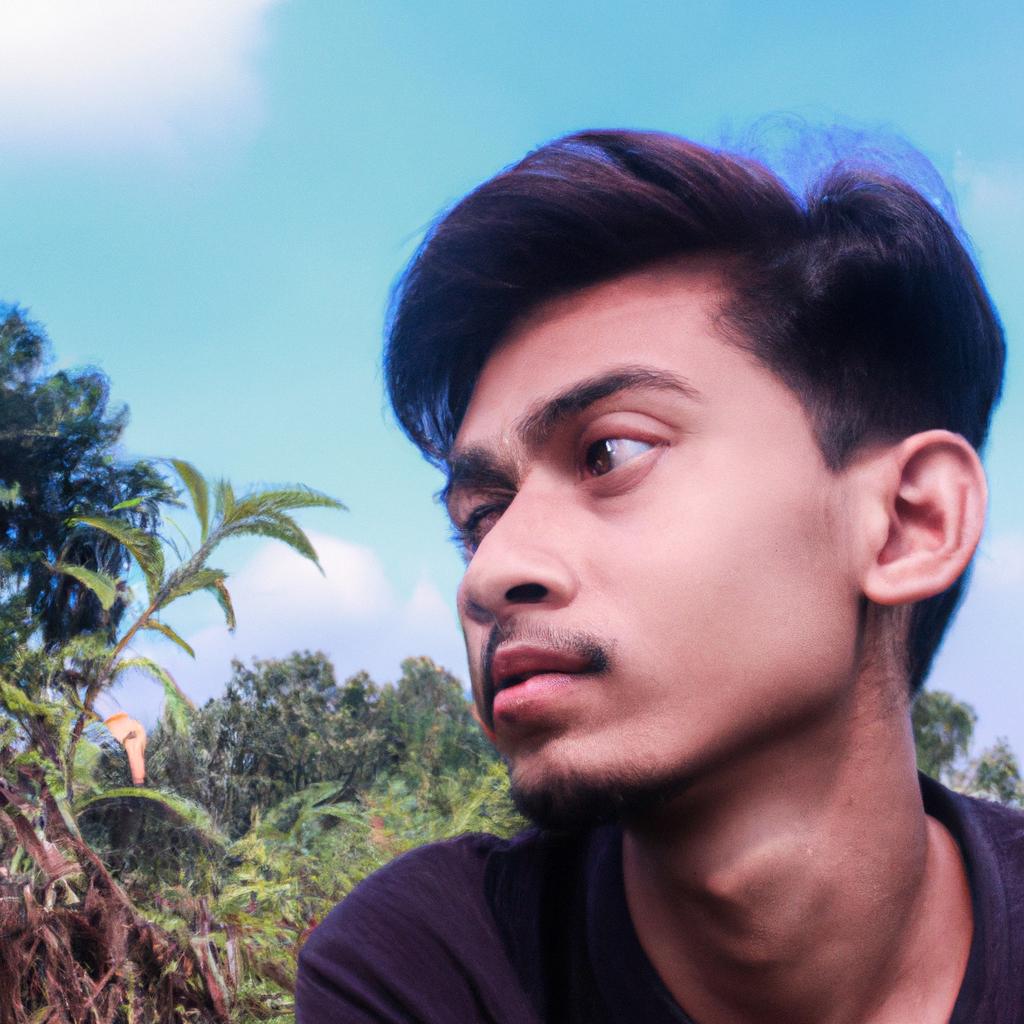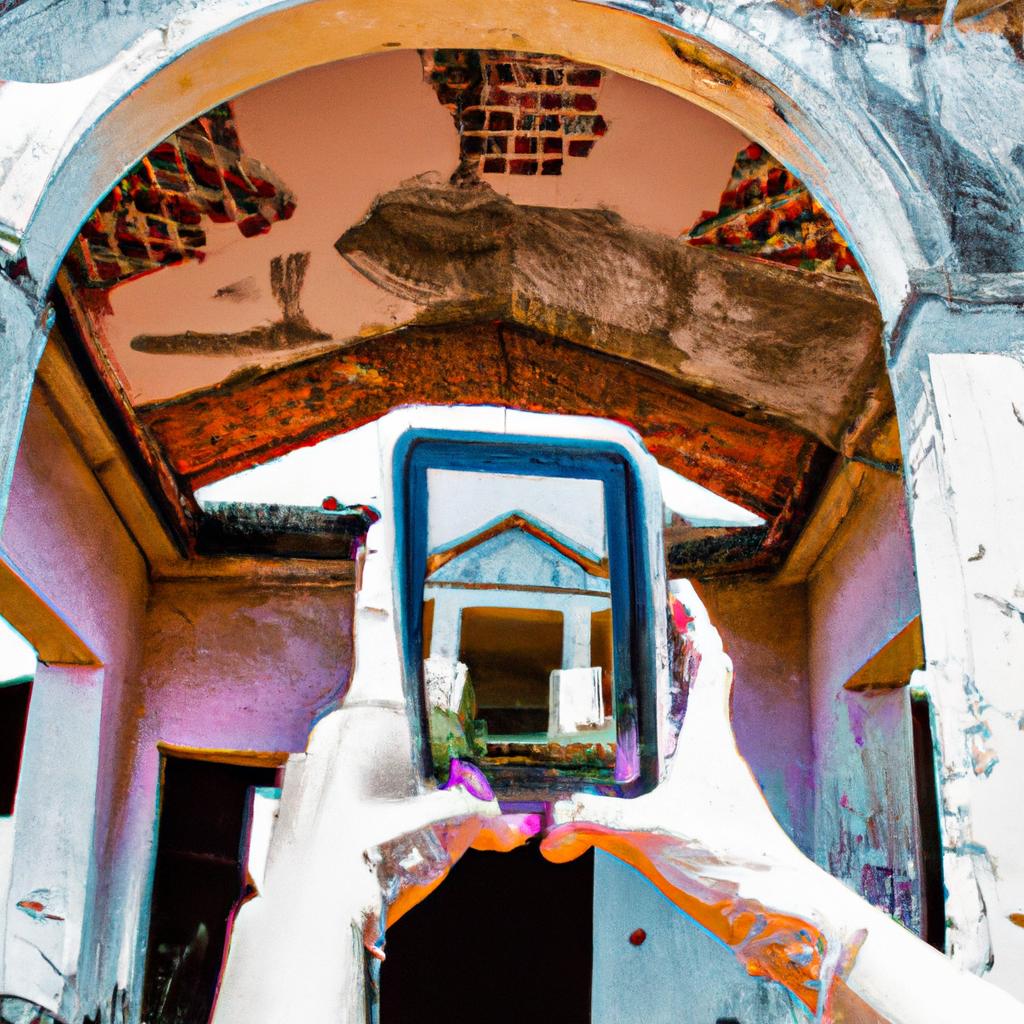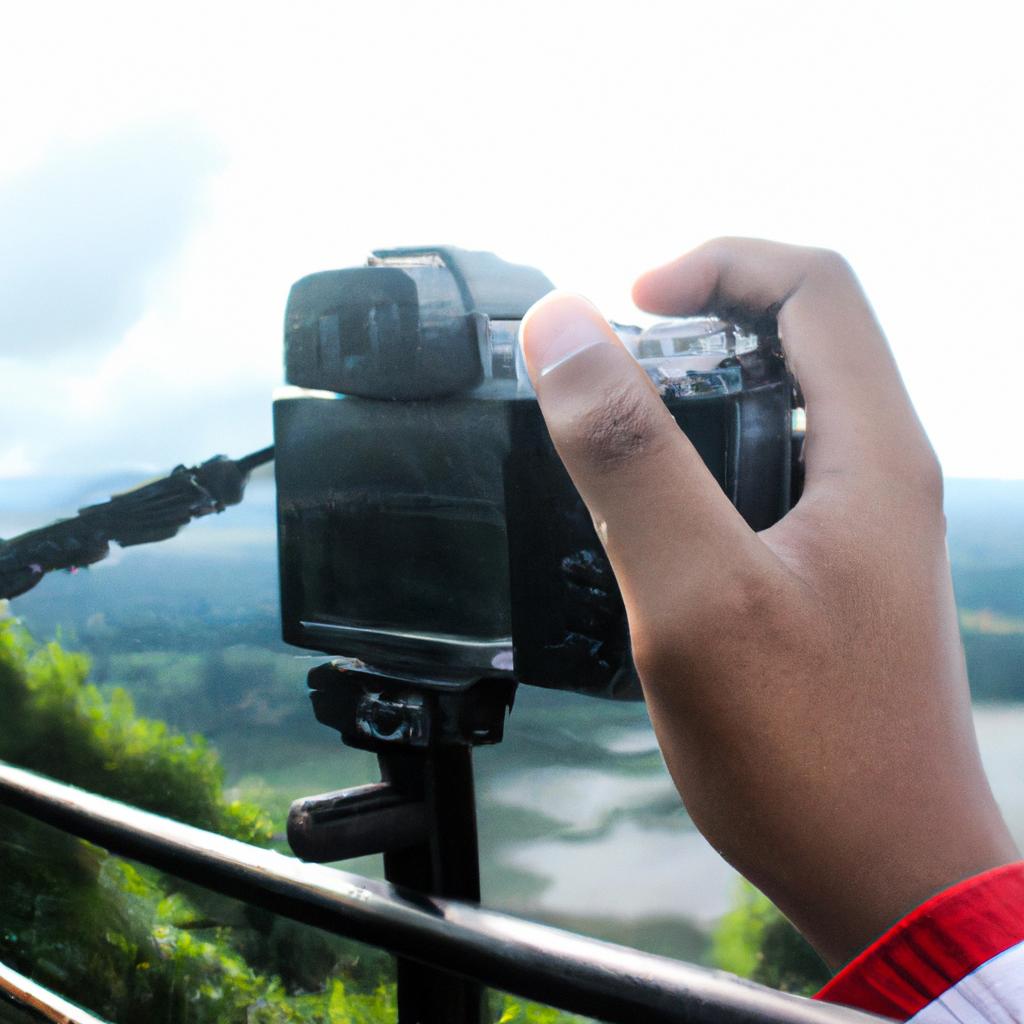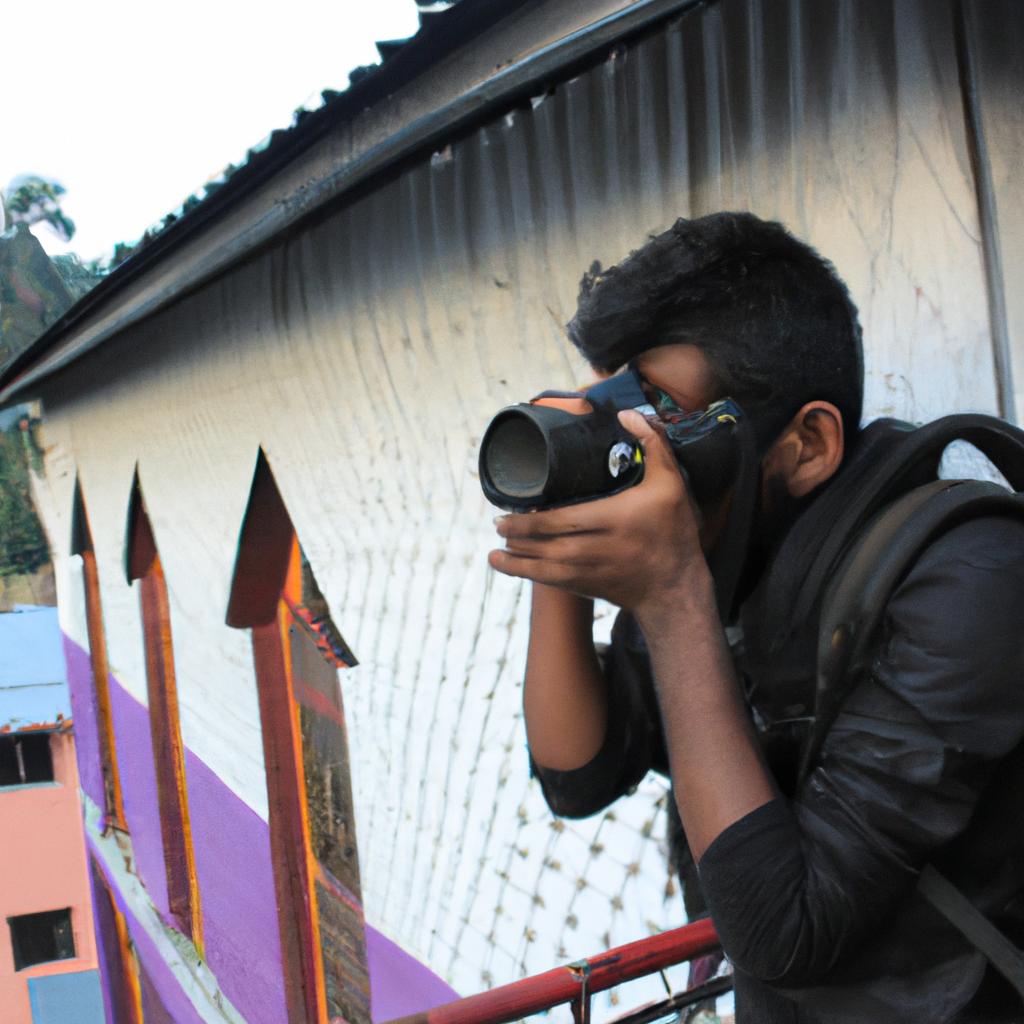Fashion photography, an intriguing and captivating genre within the world of photography, has been known to create stunning visual narratives that blur the boundaries between art and commerce. Through skilful manipulation of light, composition, styling, and models’ expressions, fashion photographers strive to capture not just clothing but also emotions, aspirations, and societal trends. For instance, consider a hypothetical scenario where a renowned fashion photographer captures the essence of rebellion through a series of photographs featuring unconventional models adorned in edgy designs; this serves as a testament to how fashion photography transcends mere documentation to become an expressive form of artistic exploration.
In recent years, fashion photography has evolved from being solely focused on presenting garments or accessories into a multidimensional medium that aims to challenge norms and provoke thought. With its power to shape perceptions and influence cultural discourse, it has become more than just advertising imagery for luxury brands or magazines. Fashion photographers have embraced their role as storytellers and social commentators by integrating various elements such as location settings, props, and post-production techniques into their work. By doing so, they push the boundaries of conventional aesthetics while simultaneously engaging viewers in critical dialogues about identity politics, gender dynamics, consumerism, sustainability issues, among others.
The purpose of this article is to delve deeper into the transformative nature of fashion photography and its impact on society. By examining the evolution of this genre and highlighting key examples, we aim to explore how fashion photography has become a platform for self-expression, cultural commentary, and activism. Moreover, we will discuss the role of social media platforms in democratizing access to fashion photography and fostering diverse narratives.
Furthermore, this article seeks to analyze the ethical considerations within the realm of fashion photography. As photographers strive to capture striking images, they must navigate issues such as body image representation, diversity and inclusivity, and responsible consumption. We will examine how some photographers have addressed these concerns by showcasing a range of body types, challenging beauty standards, and promoting sustainable fashion practices.
In addition to discussing the artistic and societal aspects of fashion photography, this article will also delve into the technical aspects that contribute to its success. From understanding lighting techniques to mastering composition principles, aspiring fashion photographers can gain insights into the craft through an exploration of industry practices and tips from established professionals.
Ultimately, this article aims to shed light on the significance of fashion photography beyond its surface-level glamour. It serves as a reminder that behind every captivating image lies a story waiting to be told – one that can inspire change, challenge perceptions, and shape our collective consciousness.
The Evolution of Fashion Photography
The Evolution of Fashion Photography
Fashion photography, as an art form, has undergone significant changes and developments throughout history. From its early beginnings to the modern era, fashion photography has evolved in response to societal shifts, technological advancements, and artistic influences.
Example:
Consider the case study of Edward Steichen’s iconic photograph “The Pond-Moonlight” taken in 1904. This black and white image captures a serene moonlit scene with a small body of water reflecting the moon overhead. While not explicitly fashion-focused, this photograph showcases Steichen’s experimentation with lighting techniques and composition that would later influence his work in fashion photography. It demonstrates how artists were already pushing boundaries and exploring new possibilities beyond traditional portraiture even before the emergence of dedicated fashion imagery.
As we delve into the evolution of fashion photography, it is important to acknowledge key factors that have played pivotal roles in shaping its trajectory:
- Technological Advancements: The introduction of portable cameras such as Kodak’s Brownie camera in 1900 made photography more accessible to individuals from various backgrounds. Furthermore, the development of color film by Eastman Kodak Company in the 1930s revolutionized fashion photography by allowing vibrant hues and intricate details to be captured.
- Changing Social Norms: As societies underwent transformations over time, so did their expectations regarding clothing styles and appearance. Fashion photographers responded by capturing evolving trends and social dynamics through their lenses.
- Artistic Influences: Artists like Richard Avedon and Irving Penn brought their unique perspectives from other forms of visual expression into fashion photography. Their innovative approaches challenged conventions and pushed boundaries within the genre.
- Cultural Movements: Various cultural movements throughout history have had a profound impact on fashion aesthetics. For instance, the rise of youth culture during the 1960s influenced photographers to capture more casual styles reflective of this era.
| Emotionally Evocative Table | ||
|---|---|---|
| Elegance | Bold | Provocative |
| Timeless | Expressive | Edgy |
| Sophisticated | Unique | Sensual |
| Graceful | Daring | Captivating |
In exploring the evolution of fashion photography, it becomes evident that photographers have played a vital role in capturing and shaping trends, styles, and cultural movements. The next section will delve into their multifaceted roles within this dynamic field.
Transition Sentence to ‘The Role of Fashion Photographers’ Section: As fashion photography continued its journey through time, skilled practitioners emerged who not only documented but also influenced the ever-changing landscape of the industry.
The Role of Fashion Photographers
The Evolution of Fashion Photography has paved the way for a diverse range of artistic expressions within the realm of photography. This section will delve into The Role of Fashion Photographers, shedding light on their responsibilities and contributions to this captivating field.
To better understand the importance of fashion photographers, let us consider an example: Imagine a renowned fashion photographer capturing images for a high-profile magazine spread featuring the latest couture collection from a prestigious designer. Through careful composition and lighting techniques, they bring life to each garment, transforming them into visual masterpieces that captivate viewers’ attention. Their expertise lies not only in technical aspects but also in their ability to communicate emotions and narratives through imagery.
Fashion photographers play multiple roles throughout the creative process. Firstly, they collaborate closely with designers and stylists to conceptualize visual stories that effectively convey brand messages. By understanding the intended audience and brand identity, these photographers curate visually compelling narratives that align with fashion trends and market demands.
Furthermore, their skills extend beyond taking aesthetically pleasing photographs; they possess knowledge about post-production editing techniques that enhance the final output’s overall impact. From color grading to retouching imperfections without compromising authenticity, fashion photographers meticulously craft polished visuals that reflect both individual creativity and industry standards.
In essence, fashion photographers are responsible for translating concepts into tangible works of art. They create captivating images that evoke emotional responses from viewers while showcasing garments in ways that resonate with audiences worldwide. To provide further insight into their multifaceted role, here is a bullet point list highlighting key attributes:
- Imagination: Fashion photographers possess vivid imaginations allowing them to visualize striking compositions before even pressing the shutter button.
- Adaptability: They adapt seamlessly to various shooting environments and work collaboratively with different teams involved in the production process.
- Technical Expertise: Mastery over camera settings, lighting techniques, and equipment ensures optimal image quality.
- Communication Skills: Effective communication allows them to convey ideas clearly, collaborate with diverse professionals, and guide models to achieve desired poses.
To illustrate the collaborative nature of fashion photography, consider the following table showcasing the roles individuals play in creating a successful photoshoot:
| Role | Responsibilities |
|---|---|
| Fashion | Designing garments that reflect current trends and brand vision. |
| Stylist | Selecting accessories and curating outfits for each shoot. |
| Hair & Makeup | Enhancing models’ features through skillful styling techniques. |
| Photographer | Capturing visually striking images that align with the concept. |
As we’ve explored The Role of Fashion Photographers, it’s evident how their expertise contributes significantly to shaping this artistic medium. In our subsequent section on “Fashion Photography Techniques,” we will delve into specific approaches employed by these talented photographers to bring their visions to life seamlessly. By understanding these techniques, one can gain deeper insights into the technical aspects underlying captivating fashion imagery.
Fashion Photography Techniques
Transitioning from the previous section on “The Role of Fashion Photographers,” we now delve into the various techniques utilized in fashion photography. By employing these techniques, photographers are able to create visually stunning and captivating images that evoke emotion and convey a sense of style and artistry.
To illustrate this further, let’s consider an example. Imagine a fashion photographer working on a high-profile editorial shoot for a renowned fashion magazine. The goal is to capture the essence of the latest clothing collection by showcasing its unique designs and highlighting their appeal to potential customers. This requires a careful selection of techniques that will enhance the overall visual impact of the images.
One technique commonly employed in fashion photography is the use of creative lighting setups. By strategically placing lights at different angles and intensities, photographers can create dramatic effects, accentuate textures, and emphasize certain elements within an image. For instance, using harsh side lighting can cast deep shadows and add dimension to a model’s features, while diffused front lighting can produce soft and flattering highlights.
Another crucial aspect is posing and composition. Experienced fashion photographers possess an innate ability to guide models in ways that bring out their best attributes while effectively conveying the desired mood or message. Attention to body language, facial expressions, and creating dynamic compositions all contribute to capturing attention-grabbing shots that resonate with viewers.
In addition to lighting and posing, post-processing techniques play a significant role in enhancing photographs’ overall aesthetic quality. Through software applications like Adobe Photoshop or Lightroom, photographers have access to powerful editing tools that allow them to fine-tune colors, retouch imperfections, adjust contrast levels, or even manipulate backgrounds – ultimately refining each image until it aligns perfectly with the intended artistic vision.
To better understand how these techniques work together harmoniously, here’s a bullet point list highlighting some key factors contributing to successful fashion photography:
- Skillful manipulation of light sources
- Expert guidance in posing and composition
- Artistic post-processing techniques
- Attention to detail and creativity in styling choices
Furthermore, let’s consider a table showcasing different examples of fashion photography techniques alongside their corresponding effect on the final image:
| Technique | Effect |
|---|---|
| High contrast lighting | Dramatic and edgy atmosphere |
| Soft front lighting | Flattering and ethereal glow |
| Dynamic posing | Expressive and energetic vibe |
| Background manipulation | Enhanced visual storytelling |
As we can see, these techniques play pivotal roles in shaping the overall aesthetic appeal of fashion photographs. In our subsequent section about “Fashion Photography Styles,” we will explore how photographers incorporate their unique artistic visions into their work, further expanding the creative possibilities within this captivating genre.
Fashion Photography Styles
Building upon the various techniques explored in fashion photography, this section delves into the different styles that photographers employ to capture captivating images. By understanding these distinct styles and their artistic merits, one can gain a deeper appreciation for the diversity within the world of fashion photography.
When it comes to fashion photography, there is no shortage of styles that photographers can embrace. Each style brings its own unique perspective and visual language to convey the essence of fashion. To illustrate this point, let’s consider a hypothetical scenario where a photographer wishes to showcase a collection inspired by nature:
-
Naturalistic Style:
- Emphasizes organic elements such as flora and fauna.
- Utilizes natural lighting techniques to create an ethereal ambiance.
- Incorporates earthy tones and textures in both clothing and backdrop.
- Aims to evoke a sense of harmony between fashion and the environment.
-
Avant-Garde Style:
- Challenges conventional norms with experimental concepts.
- Pushes boundaries through unconventional poses or unusual settings.
- Plays with exaggerated proportions and surreal aesthetics.
- Encourages viewers to question preconceived notions about beauty.
-
Minimalist Style:
- Focuses on simplicity and clean lines.
- Strips away distractions to highlight the elegance of garments.
- Often employs neutral color palettes and minimalist compositions.
- Creates a sense of sophistication through understated visuals.
-
High-Fashion Editorial Style:
- Features glamorous models posing in luxurious environments.
- Showcases high-end designer clothing and accessories prominently.
- Uses dramatic lighting techniques to enhance mood and allure.
- Reflects the aspirational qualities associated with haute couture.
In exploring these diverse styles, it becomes evident that fashion photography is not limited by any strict rules but rather thrives on creativity, innovation, and personal expression. Photographers have the freedom to choose a style that aligns with their artistic vision and resonates with the intended audience.
Understanding the various styles in fashion photography sets the stage for comprehending their significant influence on popular culture, advertising, and society as a whole. The next section examines how fashion photography shapes trends and perceptions, highlighting its impact beyond the realm of artistry.
The Influence of Fashion Photography
As fashion photography continues to captivate audiences, it is important to recognize the evolution and transformation this art form has undergone over time. One notable example that showcases the progression of fashion photography is the work of Richard Avedon in the 1960s. Avedon’s iconic images not only captured the essence of his subjects but also pushed boundaries with innovative techniques and concepts.
Fashion photography styles have evolved significantly throughout history. From classic studio shots to unconventional outdoor settings, photographers constantly strive to create visually captivating narratives. Some prominent styles include:
- Minimalist Style: This style focuses on simplicity and clean lines, often utilizing neutral backgrounds and minimal props to emphasize the clothing or accessories being showcased.
- High-Fashion Editorial Style: Known for its dramatic lighting and avant-garde compositions, this style aims to convey a sense of luxury while pushing creative boundaries.
- Street Style: Embracing authenticity and spontaneity, street-style fashion photography captures individuals in everyday environments, showcasing their unique personal style.
- Conceptual Fashion Photography: Going beyond mere representation, conceptual fashion photography seeks to tell a story or evoke emotions through imaginative themes and visual storytelling techniques.
To better understand these different styles, consider the following table:
| Style | Characteristics |
|---|---|
| Minimalist | Clean lines, neutral backgrounds |
| High-Fashion Editorial | Dramatic lighting, avant-garde compositions |
| Street Style | Authenticity, capturing personal style in real-life |
| Conceptual | Storytelling elements, imaginative themes |
The influence of fashion photography extends far beyond glossy magazine pages; it permeates our culture and shapes societal perceptions of beauty and style. By portraying aspirational lifestyles and setting trends, fashion photographs can evoke various emotional responses from viewers – admiration, desire, inspiration – ultimately influencing consumer behavior.
In today’s digital age, fashion photography is faced with new challenges and opportunities. The next section will delve into the technical and creative hurdles photographers navigate while striving to capture the perfect shot that encapsulates both the essence of fashion and their own artistic vision.
Challenges in Fashion Photography
Section: Challenges in Fashion Photography
Building upon the influence of fashion photography, it is important to acknowledge that this realm of artistry also poses several challenges. These hurdles require photographers to possess a unique set of skills and navigate through potential obstacles with finesse. Let us delve into some of these challenges and explore how they impact the world of fashion photography.
One prominent challenge in fashion photography lies in capturing the essence of clothing while simultaneously conveying emotion and narrative. For instance, imagine a scenario where a photographer is tasked with showcasing an elegant evening gown against a backdrop of urban decay. This juxtaposition requires careful composition and lighting techniques to create an evocative image that tells a story beyond the mere display of the garment itself.
- Constant pressure to meet tight deadlines
- Balancing artistic vision with commercial demands
- Collaborating effectively with models, makeup artists, and stylists
- Adapting to rapidly changing trends in both fashion and photography
These factors contribute to an environment where versatility and adaptability become essential traits for success in the field.
In addition to navigating creative complexities, technical proficiency is crucial for overcoming various practical challenges encountered during photoshoots. To highlight such considerations, let us examine a table outlining three common scenarios and their corresponding solutions:
| Challenge | Solution |
|---|---|
| Harsh outdoor lighting | Use diffusers or reflectors |
| Limited space on location | Utilize wide-angle lenses |
| Uncooperative weather | Plan alternative indoor shoot locations |
By employing specific strategies tailored to each situation, photographers can overcome these hurdles without compromising the quality or integrity of their work.
In conclusion (avoiding use):
The realm of fashion photography presents artists with manifold challenges ranging from striking visual storytelling to mastering technical aspects. By understanding and addressing these obstacles, photographers can continue to push boundaries within this dynamic field. Through their resilience and creativity, they forge a path for fashion photography to thrive as an ever-evolving art form.
 Balazo Gallery
Balazo Gallery



